| |
|
Combs,
pronounced to rhyme with looms, is a
large parish, and although there is a remote,
pretty village that takes its name up in the
hills, the bulk of the population of the parish
is down in the housing estate of Combs Ford in
suburban Stowmarket. Consequently, this church is
often busy with baptisms and weddings, and can
reckon on a goodly number of the faithful on a
Sunday morning.
St Mary is on the edge of the housing estate, but
the setting is otherwise profoundly rural: you
reach it along a doglegging lane from the top of
Poplar Hill, and the last few hundred yards is
along a narrow track which ends in the wide
graveyard. The church is set on low ground, hills
rising away to north and south, and the effect,
on looking down at it, is of a great ship at rest
in harbour.
With its grand tower, aisles and clerestories
this is a perfect example of a 15th Century
Suffolk church in all its glory. In the 1930s,
Cautley found the main entrance through the south
porch, a grand red brick affair of the late 15th
century. It has since been bricked up, and
entrance is through the smaller north porch,
which faces the estate. The gloom of the north
porch leads you into a tall, wide open space,
full of light, as if the morning had followed you
in from outside. If you had been here ten years
ago, the first striking sight would have been the
three great bells on the floor at the west end.
They represented the late medieval and early
modern work of three of East Anglia's great
bell-founding families, the Brayers of Norwich
and the Graye and Darbie families of Ipswich. The
largest dates from the mid-15th century, and was
cast by Richard Brayser. Its inscription invokes
the prayers of St John the Baptist. The other two
come from either side of the 17th century
Commonwealth; that by Miles Graye would have been
a sonorous accompaniement to Laudian piety, while
John Darbie's would have rung in the Restoration.
It was fascinating to be able to see them at such
close quarters, but they have now been rehung in
the tower.
Stretching eastwards is the range of 15th century
benches with their predominantly animal bench
ends, some 19th Century but mostly medieval in
origin, albeit heartily restored and even
replaced by the Victorians. The effect is similar
to that at Woolpit a few miles to the west. The
hares seem alert and wary, as though they might
bolt at any moment. Clearly, the medieval artist
had seen a hare, but lions were creatures of his
imagination.
 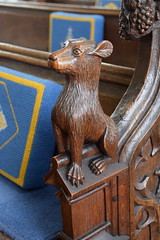    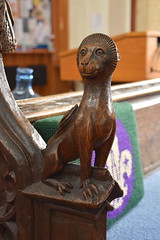 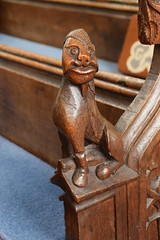 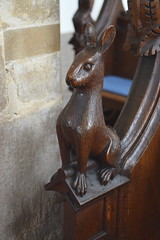   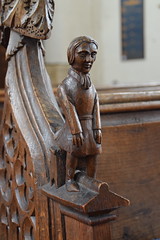   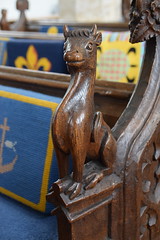     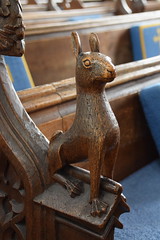   
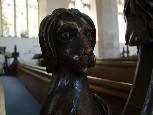  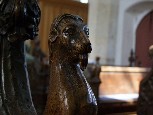 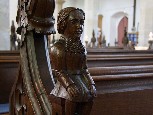 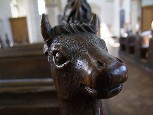 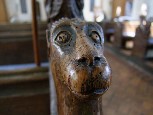  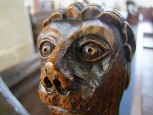  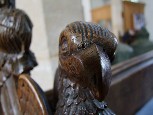 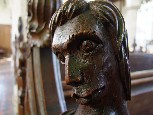 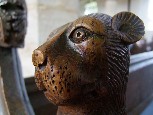 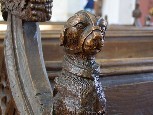  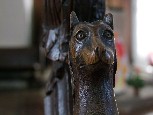  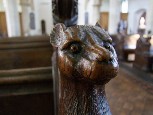 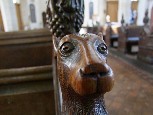   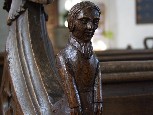  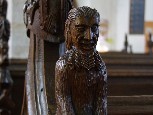 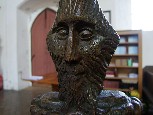
The great
glory of this church, however, is the range of
15th century glass towards the east end of the
south aisle. It was collected together in this
corner of the church after the factory explosion
that wrecked most of Stowmarket and killed 28
people in August 1871. The east window and most
easterly south window contain figures from a Tree
of Jesse, a family tree of Christ. Old Testament
prophets and patriarchs mix with kings, most of
them clearly labelled: Abraham and his son Isaac
wait patiently near the top, and Solomon and
David are also close companions.
This second window also contains two surviving
scenes from the Seven Works of Mercy, 'give food
to the hungry' and 'give water to the thirsty'.
But the most remarkable glass here consists of
scenes from the life and martyrdom of St
Margaret. We see her receiving God's blessing as
she tends her sheep (who graze on, apparently
unconcerned). We see her tortured while chained
to the castle wall. We see her about to be boiled
in oil, and most effectively in a composite scene
at once being eaten by a dragon and escaping from
it. Because there is so much 15th Century glass
at Combs, I have organised the panels here window
by window, bearing in mind that all this glass is
reset and is not in its original place in the
church. Hovering over the image should produce a
description, and there's more information when
you click through.
south
aisle, second window from the east:
  
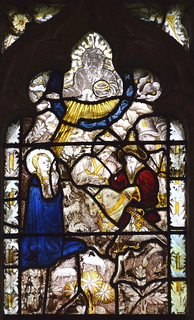  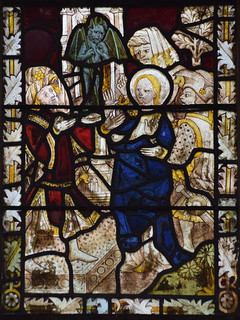
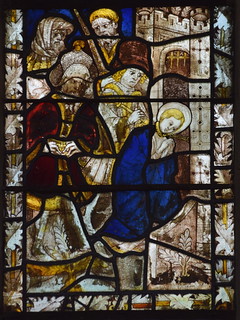 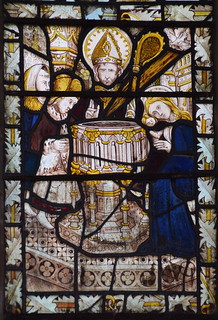 
south
aisle, first window from the east:
 
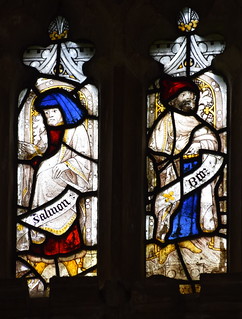  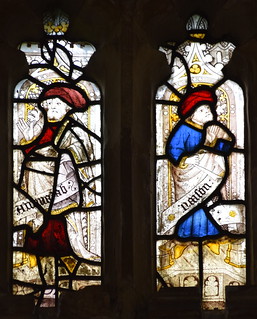
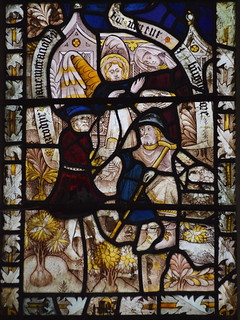  
south
aisle, east window:
 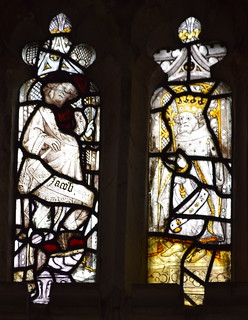  
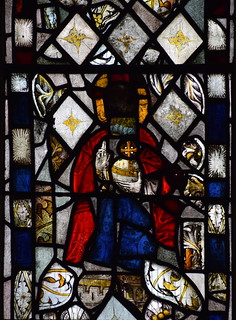  
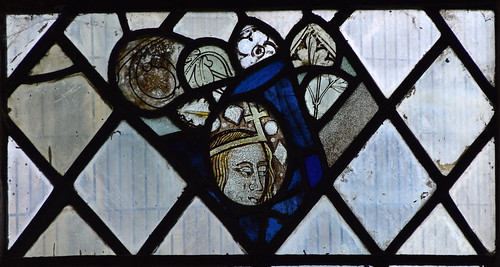
glass
elsewhere in the church:
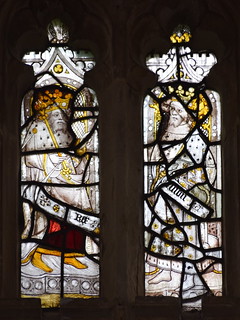 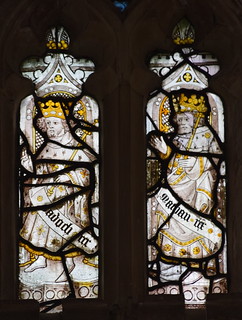 
 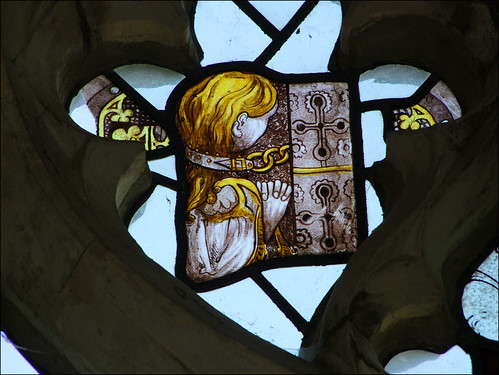
Under the vast chancel arch
is the surviving dado of the late 14th/early 15th
Century roodscreen, a substantial structure
carved and studded with ogee arches beneath
trefoiled tracery, the carvings in the spandrels
gilded. At the other end of the church, the font
is imposing in the cleared space of the west end.
It is contemporary with the roodscreen, and the
suggestion is that we are seeing a building that
is not far off being all of a piece: the fixtures
and fittings of a new building roughly a century
before the Reformation.
A period of history not otherwise much
represented here is that of the early Stuarts,
but a brass inscription of 1624 reset on a wall
had echoes of Shakespeare: Fare well, deare
wife, since thou art now absent from mortalls
sight. One of those moments when the human
experience transcends the religious tussles of
those days.
Outside in the graveyard, two other memorials
caught my eye. One dates from 1931, and remembers
My Beloved Sweetheart Stan... who died in
Aden aged 22 years. Not far off, a small
headstone of the late 17th Century records that Here
Restesth ye body of Mary, ye wife of Tho. Love
Coroner with two still born Children. I
stood in the quiet of the graveyard, looking
across to the suburbs of the busy town of
Stowmarket, and I felt the heartbeat, the
connection down the long Combs Ford centuries.
Behind me, there was something rather curious.
Although this is a big graveyard, the church is
set hard against the western edge of it. Because
of this, a processional way was built through the
base of the tower by the original builders, as at
Ipswich St Lawrence and Stanton St John. This
would have allowed medieval processions to
circumnavigate the church on consecrated ground.
The way here has since been blocked in, and is
used as storage space. A surviving stoup inside
shows that, through this processional way, the
west door was the main entrance to the church in
medieval times, when this building was the still
point of the people's turning world.
|
|
|

